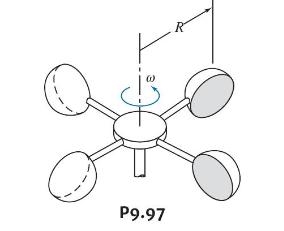An anemometer to measure wind speed is made from four hemispherical cups of 2-in. diameter, as shown.
Question:
An anemometer to measure wind speed is made from four hemispherical cups of 2-in. diameter, as shown. The center of each cup is placed at \(R=3\) in. from the pivot. Find the theoretical calibration constant, \(k\), in the calibration equation \(V=k \omega\), where \(V(\mathrm{mph})\) is the wind speed and \(\omega(\mathrm{rpm})\) is the rotation speed. In your analysis, base the torque calculations on the drag generated at the instant when two of the cups are orthogonal and the other two cups are parallel, and ignore friction in the bearings. Explain why, in the absence of friction, at any given wind speed, the anemometer runs at constant speed rather than accelerating without limit. If the actual anemometer bearing has constant friction such that the anemometer needs a minimum wind speed of \(0.5 \mathrm{mph}\) to begin rotating, compare the rotation speeds with and without friction for \(V=20 \mathrm{mph}\).

Step by Step Answer:

Fox And McDonald's Introduction To Fluid Mechanics
ISBN: 9781118912652
9th Edition
Authors: Philip J. Pritchard, John W. Mitchell





